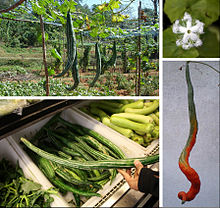Serpent gourd
| Snake gourd | |
|---|---|
 |
|
| Snake gourd | |
| Scientific classification | |
| Kingdom: | Plantae |
| (unranked): | Angiosperms |
| (unranked): | Eudicots |
| (unranked): | Rosids |
| Order: | Cucurbitales |
| Family: | Cucurbitaceae |
| Genus: | Trichosanthes |
| Species: | T. cucumerina |
| Binomial name | |
|
Trichosanthes cucumerina L. |
|
| Synonyms | |
|
|
Trichosanthes cucumerina is a tropical or subtropical vine, its variety T. cucumerina var. anguina raised for its strikingly long fruit, in Asia eaten immature as a vegetable much like the summer squash, and in Africa, the reddish pulp of its mature fruit is used as an economical substitute of tomato. Common names of the cultivated variety include snake gourd,serpent gourd,chichinda, and padwal (not to be confused with Trichosanthes dioica, the parwal, another gourd edible when immature).
Trichosanthes cucumerina is found in the wild across much of South and Southeast Asia, including India, Bangladesh, Nepal, Pakistan, Sri Lanka, Indonesia, Malaysia, Myanmar (Burma), and southern China (Guangxi and Yunnan). It is also regarded as native in northern Australia. and naturalized in Florida, parts of Africa and on various islands in the Indian and Pacific Oceans.
Formerly, the cultivated form was considered a distinct species, T. anguina, but it is now generally regarded as conspecific with the wild populations, as they freely interbreed:
Trichosanthes cucumerina is a monoecious annual vine climbing by means of tendrils. Leaves are palmately lobed, up to 25 cm long. Flowers are unisexual, white, opening at night, with long branching hairs on the margins of the petals. These hairs are curled up in the daytime when the flower is closed, but unfurl at night to form a delicate lacy display (see photos in gallery below). Fruits can be up to 200 cm long, deep red at maturity, hanging below the vine.
...
Wikipedia
